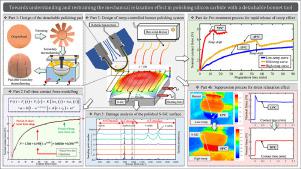International Journal of Mechanical Sciences ( IF 7.1 ) Pub Date : 2022-11-20 , DOI: 10.1016/j.ijmecsci.2022.107962 Yifan Zhang , Jingbo Feng , Yuyang Zhao , Mengqi Rao , Yuehong Yin

|
Bonnet polishing has shown promising shape adaptability and processing quality in the surface finishing of glass-ceramic optical components with complex surfaces. This study proposed a new robotic bonnet polishing device with a detachable polishing cloth to realize relatively high polishing accuracy on sintered silicon carbide (S-SiC) with low cost and pollution. During polishing, the contact state between the secondary-thermoformed polishing cloth and workpiece was found to follow a complex force curve, including a short-term force drop caused by quasi-stress relaxation and a long-term force rise caused by creep. Therefore, a predictive model was established to modify the removal efficiency error induced by force fluctuation and to estimate the remaining service time. On this basis, a new approach was proposed to accelerate the initial-stage creep and restrain the force drop during polishing via temperature control. The results obtained in tool influence function and form correction experiments proved that the temperature threshold to suppress the stress relaxation effect of the polishing pad is around 45°C. Meanwhile, the pre-treatment time of the pad can be compressed by more than half at this temperature to maintain the high determinacy and efficiency of the polishing process. After polishing, almost no subsurface damage was detected near the surface of the S-SiC block. However, due to the impact of original micropores and the scratches caused by the abrasive aggregation effect, the roughness is challenging to continue decreasing after Ra reaches 3∼4 nm.
中文翻译:

理解和抑制使用可拆卸阀盖工具抛光碳化硅的机械松弛效应
阀盖抛光在具有复杂表面的微晶玻璃光学元件的表面抛光中显示出良好的形状适应性和加工质量。本研究提出了一种新型的带有可拆卸抛光布的机器人端盖抛光装置,以低成本和无污染的方式在烧结碳化硅(S-SiC)上实现相对较高的抛光精度。在抛光过程中,发现二次热成型抛光布与工件之间的接触状态遵循复杂的力曲线,包括由准应力松弛引起的短期力下降和由蠕变引起的长期力上升。因此,建立了一个预测模型来修改由力波动引起的去除效率误差并估计剩余服务时间。以这个为基础,提出了一种新的方法来通过温度控制来加速初始阶段的蠕变并抑制抛光过程中的力下降。工具影响函数和形状校正实验得到的结果证明,抑制抛光垫应力松弛效应的温度阈值在45℃左右。同时,在此温度下,抛光垫的预处理时间可缩短一半以上,以保持抛光过程的高确定性和高效率。抛光后,在 S-SiC 块的表面附近几乎没有检测到亚表面损伤。然而,由于原始微孔的影响和磨料聚集效应造成的划痕,Ra达到3∼4 nm后粗糙度难以继续降低。工具影响函数和形状校正实验得到的结果证明,抑制抛光垫应力松弛效应的温度阈值在45℃左右。同时,在此温度下,抛光垫的预处理时间可缩短一半以上,以保持抛光过程的高确定性和高效率。抛光后,在 S-SiC 块的表面附近几乎没有检测到亚表面损伤。然而,由于原始微孔的影响和磨料聚集效应造成的划痕,Ra达到3∼4 nm后粗糙度难以继续降低。工具影响函数和形状校正实验得到的结果证明,抑制抛光垫应力松弛效应的温度阈值在45℃左右。同时,在此温度下,抛光垫的预处理时间可缩短一半以上,以保持抛光过程的高确定性和高效率。抛光后,在 S-SiC 块的表面附近几乎没有检测到亚表面损伤。然而,由于原始微孔的影响和磨料聚集效应造成的划痕,Ra达到3∼4 nm后粗糙度难以继续降低。同时,在此温度下,抛光垫的预处理时间可缩短一半以上,以保持抛光过程的高确定性和高效率。抛光后,在 S-SiC 块的表面附近几乎没有检测到亚表面损伤。然而,由于原始微孔的影响和磨料聚集效应造成的划痕,Ra达到3∼4 nm后粗糙度难以继续降低。同时,在此温度下,抛光垫的预处理时间可缩短一半以上,以保持抛光过程的高确定性和高效率。抛光后,在 S-SiC 块的表面附近几乎没有检测到亚表面损伤。然而,由于原始微孔的影响和磨料聚集效应造成的划痕,Ra达到3∼4 nm后粗糙度难以继续降低。











































 京公网安备 11010802027423号
京公网安备 11010802027423号